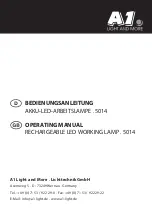
For advice on the safety and suitability of this
equipment contact your local HSS Hire.
There is a serious risk of personal injury if you do not
follow all instructions laid down in this guide.
This equipment is designed to be used by an able
bodied, competent adult who has read and understood
these instructions. Anyone with either a temporary or
permanent disability should seek expert advice before
using it.
Keep children, animals and bystanders away from the
work area. Cordon off a NO GO area using cones and
either barriers or tape, available for hire from your local
HSS Hire.
Never use this equipment if you are ill, feeling
tired, or under the influence of alcohol or
drugs.
Wear practical protective clothing and
footwear plus any safety wear appropriate to
the work in progress.
Don’t use the mast floodlights in windy weather,
allow
for the fact that in blustery weather, on exposed sites or
near tall buildings gusts can be surprisingly strong.
If the wind speed is due to exceed 25mph
(a breeze
strong enough to move large tree branches)
the mast
floodlights should not be erected or used.
Allow the wind strength to subside before erecting
or
using.
If erected, dismantle the mast floodlights
or, if not
possible, make them secure by tying them in and/or using
sandbags at their base.
Keep the mast floodlights on firm, level ground, DO
NOT use on slopes or soft ground
or where there is a risk
of subsidence.
Erect the mast floodlights away from overhead power
cables
and similar hazards.
Check the condition of the equipment before use.
If it
shows signs of damage or excessive wear, return it to your
local HSS Hire.
Never leave the equipment switched ON
and unattended.
Lights get hot. Always leave them to cool before
touching them
and never remove or interfere with any
safety guards fitted.
Never use floodlights in a dusty environment
, nor in the
presence of highly flammable vapours or liquids.
HSS Mast floodlights are only available in 110V
(fitted
with a round yellow plug)
and must be provided with a
ELECTRICAL SAFETY
GENERAL SAFETY
suitable 110V generated supply
, or powered from the
mains via a suitable 110V transformer
Extension leads should be fully unwound and loosely
coiled, away from the work area.
Never run them
through water, over sharp edges or where they could trip
someone.
Using electrical equipment in very damp or wet
conditions can be dangerous.
To reduce the risk of electric shock, use a suitable
RCD
(Residual Current-Operated Device) available
from your local HSS Hire, or power 240V (not 110V)
equipment from a power circuit with a built-in RCD.
Siting an RCD
When used with a transformer an RCD will only protect
the user if fitted between the transformer and
the tool being used.
An RCD fitted between the power supply and the
transformer only protects up to the transformer.
Tool or
Lead
RCD
Transformer
Supply
If the equipment fails, or if its plug or lead gets
damaged, return it.
Never try to repair it yourself (unless
this involves replacing a halogen bulb).
Never carry or pull the equipment by its flex.
Ensure the power socket is switched OFF before
plugging into the power supply.
If using a transformer to provide power, ensure that the
total power load is less than 75% of the units power
rating.
Position lights with care
– somewhere they won’t easily
be knocked over and
where they won’t dazzle drivers,
this can be as dangerous as darkness.
Where applicable, splay out and level tripod legs and
lock in position by tightening the thumb screw.
Adjust each head so that it is pointing in the direction
you require.
Lay the unit down on the floor taking care not to
damage the lamp units or bulbs.
Uncoil the light’s flex, and raise the mast to the
required height.
By either loosening the appropriate
thumbscrews or removing the pins.
GETTING STARTED
Thumb
Screws
Thumb
Screws
Anchoring
Hole
Base Plate
Halogen




















